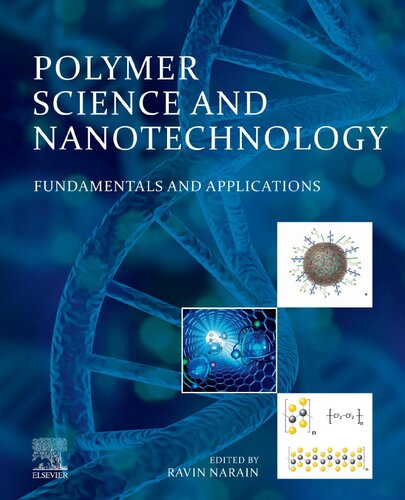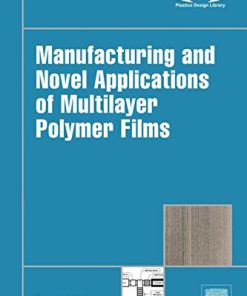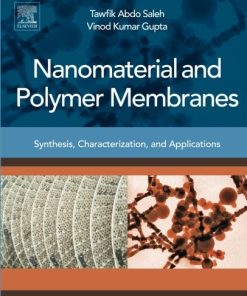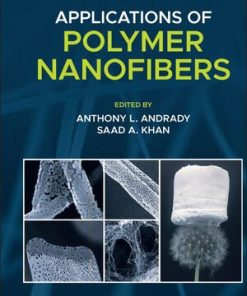Polymer Science and Nanotechnology Fundamentals and Applications 1st Edition by Ravin Narain 0128168073 9780128168073
$50.00 Original price was: $50.00.$25.00Current price is: $25.00.
Polymer Science and Nanotechnology: Fundamentals and Applications 1st Edition by Ravin Narain – Ebook PDF Instant Download/DeliveryISBN: 0128168073, 9780128168073
Full download Polymer Science and Nanotechnology: Fundamentals and Applications 1st Edition after payment.

Product details:
ISBN-10 : 0128168073
ISBN-13 : 9780128168073
Author: Ravin Narain
Polymer Science and Nanotechnology: Fundamentals and Applications brings together the latest advances in polymer science and nanoscience. Sections explain the fundamentals of polymer science, including key aspects and methods in terms of molecular structure, synthesis, characterization, microstructure, phase structure and processing and properties before discussing the materials of particular interest and utility for novel applications, such as hydrogels, natural polymers, smart polymers and polymeric biomaterials. The second part of the book examines essential techniques in nanotechnology, with an emphasis on the utilization of advanced polymeric materials in the context of nanoscience.
Throughout the book, chapters are prepared so that materials and products can be geared towards specific applications. Two chapters cover, in detail, major application areas, including fuel and solar cells, tissue engineering, drug and gene delivery, membranes, water treatment and oil recovery.
Polymer Science and Nanotechnology: Fundamentals and Applications 1st Table of contents:
Part I: Polymer science
Chapter 1: Brief overview of polymer science
1.1. Basic concepts
1.2. Classification of polymers
1.2.1. Polymer structure
1.2.2. Polymerization techniques
1.2.3. Intermolecular forces
1.3. Natural vs synthetic polymers
References
Chapter 2: Nature and molecular structure of polymers
2.1. Natural vs synthetic polymers
2.2. Structure of polymers
2.2.1. Amorphous vs crystalline polymers
2.2.2. Primary structure
2.2.2.1. Monomer polarity
2.2.3. Secondary structure
2.2.3.1. Polymer chain configuration
2.2.4. Tertiary structure
2.3. Molecular weight
References
Chapter 3: Polymer synthesis
3.1. Step-growth polymerization
3.1.1. General characteristics
3.1.2. Polymerization of tri- and higher-order functional monomers
3.1.3. Polymer types and structure
3.2. Chain-growth polymerization
3.2.1. General characteristics
3.2.2. Polymerizability (thermodynamics)
3.2.2.1. Equilibrium
3.2.3. Stereochemistry of chain-growth polymerization
3.2.4. “Living´´ versus “controlled´´ polymerization
3.2.5. Free-radical polymerization
3.2.5.1. Conventional free-radical polymerization
Initiators
Initiation
Propagation
Termination
Inhibitors
Chain transfer
Chain transfer agents
3.2.6. Kinetics of chain-growth polymerization
3.2.6.1. Initiation
3.2.6.2. Propagation
3.2.6.3. Termination
3.2.6.4. Chain transfer
3.2.6.5. Rate of polymerization
3.2.6.6. Trommsdorff-Norrish effect or auto-acceleration or gel effect
3.2.7. Controlled/living radical polymerization
3.2.7.1. Nitroxide-mediated polymerization
3.2.7.2. Atom transfer radical polymerization
Monomer
Initiator
Catalysts complex
Solvent
Temperature
3.2.7.3. Reversible addition-fragmentation chain transfer (RAFT) polymerization
RAFT procedure
RAFT mechanism
3.2.8. Ionic polymerization
3.2.8.1. Anionic polymerization
Overview
Solvent
Initiation
Electron transfer
Nucleophilic addition to the monomer double bond
Propagation
Termination
3.2.8.2. Cationic polymerization
Initiation
Bronsted acid
Lewis acid
Propagation
Termination
3.2.8.3. Group transfer polymerization
3.2.8.4. Ring-opening polymerization
Thermodynamics
Kinetics
3.2.8.5. Coordination polymerization
Ziegler-Natta catalysts
Termination
Metallocenes
3.2.8.6. Ring-opening metathesis polymerization
Catalysts
3.3. Solution polymerization
3.4. Suspension polymerization
3.4.1. Process description
3.4.2. Size control
3.4.3. Quality and morphology
3.5. Emulsion polymerization
3.5.1. Conventional emulsion polymerization
3.5.1.1. Miniemulsion
3.5.1.2. Microemulsion
Process description
Size control
3.5.2. Soapless emulsion polymerization
3.5.3. Dispersion polymerization
Further reading
Chapter 4: Copolymerization
4.1. Unspecified copolymers
4.2. Statistical copolymers
4.3. Random copolymers
4.4. Alternating copolymers
4.5. Periodic copolymers
4.6. Block copolymers
4.7. Graft copolymers
4.8. Kinetics of copolymerization
References
Chapter 5: Modification of polymers
5.1. Physical methods
5.1.1. Self-assembled monolayers
5.1.2. Radiation-induced surface modification
5.1.3. UV-irradiation
5.1.3.1. γ-Irradiation
5.1.3.2. Laser-induced surface modifications
5.2. Chemical modification of polymer
5.2.1. Common chemical reactions
5.2.2. PEGylation
5.2.3. Conjugation
5.2.4. Method to make various polymeric architecture via chemical modification
References
Further reading
Chapter 6: Polymer characterization
6.1. Measurements of molecular weight
6.1.1. Gel-permeation chromatography
6.1.2. Osmometry
6.1.3. Viscosity
6.1.4. Static light scattering
6.1.5. Principle of nuclear magnetic resonance
6.1.6. NMR equipment
6.1.7. Proton (1H) NMR
6.1.8. Carbon (13C) NMR
6.1.9. Relaxation time
6.1.10. Proton-proton correlation spectroscopy and total correlation spectroscopy
6.1.11. Heteronuclear multiple quantum coherence spectroscopy and heteronuclear multiple bond correl
6.1.12. Nuclear Overhauser effect spectroscopy
6.1.13. Diffusion ordered spectroscopy
References
Chapter 7: Polymer degradation and stability
7.1. Introduction
7.1.1. Aging and degradation
7.1.2. Influencing factors
7.1.2.1. Inherent factors
7.1.2.2. External factors
7.1.3. Evaluation and characterization
7.1.3.1. Evaluation
7.1.3.2. Characterization
7.2. Thermal and thermo-oxidative degradation
7.2.1. Thermal degradation
7.2.2. Thermo-oxidative degradation
7.2.2.1. Thermo-oxidation mechanism
7.2.2.2. Factors influencing thermo-oxidative degradation
7.2.3. Stabilization of thermal and thermo-oxidative degradation
7.2.3.1. Radical scavenger
7.2.3.2. Pro-antioxidant
7.3. Photolysis and photo-oxidative degradation
7.3.1. Photolysis
7.3.2. Photo-oxidative degradation
7.3.3. Stabilization of photolysis and photo-oxidative degradation
7.4. Hydrolysis and biodegradation
7.4.1. Hydrolysis
7.4.2. Biodegradation
7.4.3. Biodegradable polymers
7.5. Degradation and stabilization of polymer nanocomposites
References
Chapter 8: Polymer processing and rheology
8.1. Polymer processing
8.1.1. Mixing
8.1.1.1. Polymer additives
8.1.1.2. Mixing mechanics
8.1.1.3. Mixing devices
8.1.2. Extrusion
8.1.2.1. Extrusion process
8.1.2.2. Single-screw extruder
8.1.2.3. Twin-screw extruder
8.1.2.4. Extrusion dies
8.1.3. Molding
8.1.3.1. Injection molding
8.1.3.2. Compression molding
8.1.3.3. Blow molding
8.1.3.4. Rotational molding
8.1.4. Calendering
8.1.4.1. Process
8.1.4.2. Arrangements of rolls
8.1.5. Coating
8.1.5.1. Fluid coating process
8.1.5.2. Methods
8.2. Polymer rheology
8.2.1. Relationship between polymer rheology and polymer processing
8.2.2. Non-Newtonian flow
8.2.3. Viscosity of polymer melts and solutions
8.2.4. Fitting functions for the flow and viscosity curves
8.2.4.1. Model function for ideal viscous flow behavior
8.2.4.2. Model function for shear-thinning and shear-thickening flow behavior
8.2.4.3. Model function for flow curves with a yield point
8.3. Rheometry
8.3.1. Capillary rheometer
8.3.2. Couette (concentric cylinder) rheometer
8.3.3. Cone-and-plate rheometer
References
Chapter 9: Thermal, mechanical, and electrical properties
9.1. Thermal analysis of polymers
9.1.1. The melting temperature of polymers
9.1.2. Glass transition temperature of polymers
9.1.3. Thermal conductivity of polymers
9.1.4. Thermal diffusivity
9.1.5. Techniques
9.2. Differential scanning calorimeter
9.2.1. Differential thermal analysis
9.2.2. Thermomechanical analysis
9.2.3. Thermogravimetry
9.2.4. Density measurements
9.3. Mechanical properties of polymers
9.3.1. Basic concepts of stress and strain
9.3.2. Stress-strain curve
9.3.3. Dynamic mechanical analysis
9.3.4. Viscoelastic behavior of polymers
9.3.5. Effects of structure and composition on mechanical properties
9.3.5.1. Molecular weight
9.3.5.2. Cross-linking
9.3.5.3. Molecular configuration
9.3.5.4. Composition
9.4. Electrical properties of polymers
9.4.1. Conductive polymers
References
Chapter 10: Hydrogels
10.1. Introduction
10.2. Synthesis of hydrogels
10.2.1. Physically cross-linked hydrogels
10.2.1.1. Hydrogen bonds
10.2.1.2. Electrostatic interactions
10.2.1.3. Hydrophobic interactions
10.2.1.4. Crystallization
10.2.2. Chemically cross-linked hydrogels
10.2.2.1. Cross-linking by chemical reactions of complementary groups
10.2.2.2. Cross-linking by free radical polymerization
10.3. Characterization of hydrogels
10.3.1. Physical properties
10.3.2. Chemical properties
10.3.3. Mechanical properties
10.3.4. Rheological properties
10.3.5. Biological properties
10.4. Self-healing hydrogels
10.4.1. Physically self-healing hydrogels
10.4.1.1. Hydrogen bonds
10.4.1.2. Hydrophobic interactions
10.4.1.3. Metal-ligand coordination
10.4.1.4. Host-guest interactions
10.4.1.5. Combination of multiple intermolecular interactions
10.4.2. Chemically self-healing hydrogels
10.4.2.1. Phenylboronic ester complexation
10.4.2.2. Schiff base
10.4.2.3. Acylhydrazone bonds
10.4.2.4. Disulfide bonds
10.4.2.5. Other dynamic chemical bonds and reactions
10.5. Tough hydrogels
10.5.1. Homogeneous hydrogels
10.5.1.1. Tetra-PEG hydrogels
10.5.1.2. Slide-ring (SR) hydrogels
10.5.1.3. Radiation cross-linked hydrogels
10.5.2. Mechanical energy dissipating hydrogels
10.5.2.1. Double network (DN) hydrogels
10.5.3. Hydrogels based on a combination of both toughening mechanisms
10.5.3.1. Nanocomposite (NC) hydrogels
10.5.3.2. Macromolecular microspheres composite (MMC) hydrogels
References
Chapter 11: Biopolymers and natural polymers
11.1. Introduction
11.2. Production of biopolymers
11.2.1. Polysaccharides
11.2.2. Microbial biopolymers: A bioengineering approach
11.2.3. Enzymatic reactor for the production of biopolymers
11.3. Biopolymer applications
11.3.1. Drug delivery
11.3.2. Polynucleotides and protein-based therapy
11.3.3. 3D printing in tissue engineering applications
11.3.4. Sustainable biopolymer for environmental remedy
11.4. Current challenges faced by bio or natural polymers
11.5. Conclusion
References
Chapter 12: Smart polymers
12.1. Types of smart polymers
12.1.1. Temperature responsive
12.1.2. pH responsive
12.1.3. Light responsive
12.1.4. Magnetically responsive
12.1.5. Enzyme responsive
12.1.6. Other stimuli-responsive polymers
12.2. Shape memory polymers
References
Chapter 13: Polymers in medicine
13.1. Introduction
13.2. Antimicrobial polymers
13.2.1. Polymeric biocides
13.2.2. Biocidal polymers
13.2.3. Biocide-releasing polymers
13.3. Polymers in gastroenterology
13.4. Polymers in cardiology
13.5. Polymers in hemodialysis
13.6. Polymers in neurology
13.6.1. Neural implants
13.6.2. Neural drug delivery
13.7. Polymers in ophthalmology
13.7.1. Intraocular lenses (IOLs)
13.7.2. Intraocular drug delivery
13.8. Polymers in dermatology
13.8.1. Skin grafts and skin substitutes
13.8.2. Dermal and transdermal drug delivery
13.9. Polymers in orthopedic surgery
13.10. Polymers in dentistry
13.11. Polymers in cancer therapy
13.11.1. Chemotherapeutic drug delivery
13.11.2. Biosensors for cancer detection
13.12. Polymers in gene therapy
13.13. Conclusions and future outlook
References
Chapter 14: Polymers for advanced applications
14.1. Introduction
14.1.1. Polymeric membranes for gas separation
14.1.2. Applications of self-healing polymers
14.1.3. Polymers for additive manufacturing
14.1.4. Applications of polymers in electrical and electronics
14.1.5. Supercapacitors
14.1.6. Lithium-ion batteries
14.1.7. Light-emitting and sensing devices
14.1.8. Polymers for water purification
14.1.9. Polymer applications in food packaging
14.2. Conclusion and future perspectives
References
Part II: Nanotechnology
Chapter 15: Nanomaterials properties
15.1. Introduction
15.2. Physical properties
15.2.1. Size and shape of nanomaterials
15.2.2. Zero dimensional
15.2.3. One dimensional
15.2.4. Two dimensional
15.2.5. Three dimensional
15.2.6. Surface effects
15.2.7. Quantum confinement effects
15.2.8. Surface charge and stability
15.3. Chemical properties
15.3.1. Chemical structure and composition of nanomaterials
15.3.2. Catalytic reactivity
15.3.3. Optical properties
15.3.4. Magnetic properties
15.3.5. Electrical properties
References
Chapter 16: Nanomaterial synthesis
16.1. Introduction
16.2. Inorganic nanoparticles
16.2.1. Solution-phase synthesis of nanoparticles
16.2.2. Mechanism of nanoparticles synthesis
16.2.3. Typical methods for the synthesis of nanoparticles in solution phase
16.2.4. Mechanism of size and shape control of metal nanoparticles in solution phase
16.2.5. Affect of reaction parameters on nanoparticles growth
16.2.6. Template-mediated synthesis of inorganic nanostructures
16.2.7. Synthesis of inorganic nanoparticles by lithography
16.3. Organic nanoparticles
16.3.1. Bottom-up synthesis of organic nanoparticles
16.3.2. Controlling the shape of soft materials
16.3.3. Polymersomes
16.3.4. Top-down approach for the synthesis of organic nanoparticles
16.4. Conclusion and future outlook
References
Chapter 17: Nanomaterials characterization
17.1. Introduction
17.2. Size, shape, length, and internal structure characterization
17.2.1. Dynamic light scattering
17.2.2. Microscopy
17.2.2.1. Scanning electron microscopy
17.2.2.2. Transmission electron microscopy
17.2.2.3. Atomic force microscopy
17.3. Surface charge characterization of nanoparticles (zeta potential measurements)
17.4. Optical properties
17.4.1. Ultraviolet-visible spectroscopy
17.4.2. Fluorescence spectroscopy
17.5. Magnetic properties
17.6. Composition, chemical structure, and substructure
17.6.1. Nuclear magnetic resonance spectroscopy
17.6.2. X-ray diffraction
17.6.3. X-ray photoelectron spectroscopy
17.7. Mechanical properties
References
Chapter 18: Nanomaterials applications
18.1. Introduction
18.2. Household
18.3. Cosmetics
18.4. Textiles
18.5. Energy storage
18.6. Sports
18.7. Food and drinks
18.8. Automotive industry
18.9. Electronics
18.10. Construction and engineering materials
18.11. Medicine
People also search for Polymer Science and Nanotechnology: Fundamentals and Applications 1st:
polymer science jobs
what is polymer science
polymer science and engineering
polymer science and engineering jobs
polymer science and processing
Tags: Polymer Science, Nanotechnology, Fundamentals, Applications, Ravin Narain
You may also like…
Engineering
Uncategorized
Engineering












